Elders & Fyffes Ltd Passenger-Banana Liners - T.S.S. Golfito (1949) & T.S.S. Camito (1956)
Please
Note: Firefox,
iPhones,
iPads & some other Search Engines
may not be suitable
Use Internet Explorer & Old
Google for this Web
Page to load perfectly!
Please
Note: All ssmaritime and my other related
ssmaritime sites are 100% non-commercial and privately owned sites. Be assured
that I am NOT associated with any cruise or shipping companies or travel/cruise
agencies or any other organisations! The author has been in the passenger
shipping industry since May 1960 and is now semi-retired, but continues to
write article on classic liners and cruise ships in order to better to inform
cruise and ship enthusiasts for their pleasure!
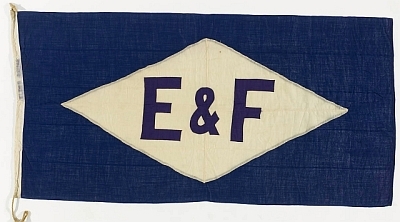
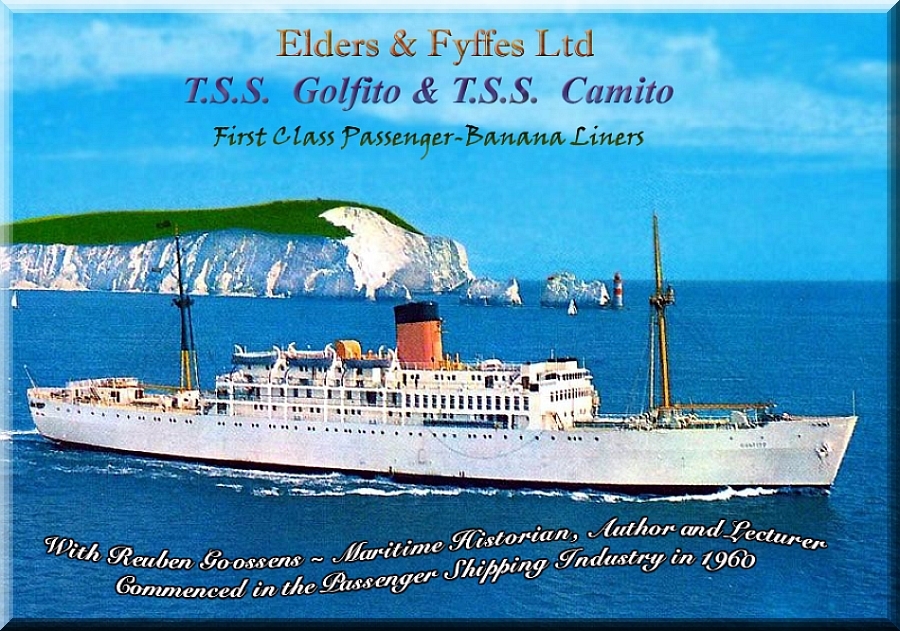
Please Note: Postcards, photographs & other images are from the Author’s private collection, unless otherwise stated.
Elders & Fyffes - A
Company History:
Although this famous banana company only commenced
as a shipping line early the 1900s, but today it is known just
“Fyffes” and they continue to operate to this very day and their
bananas are well known throughout the
With the formation of Elders & Fyffes Ltd in
1901 and it was necessary to for them obtain suitable ships to transport
bananas from the West Indies to the
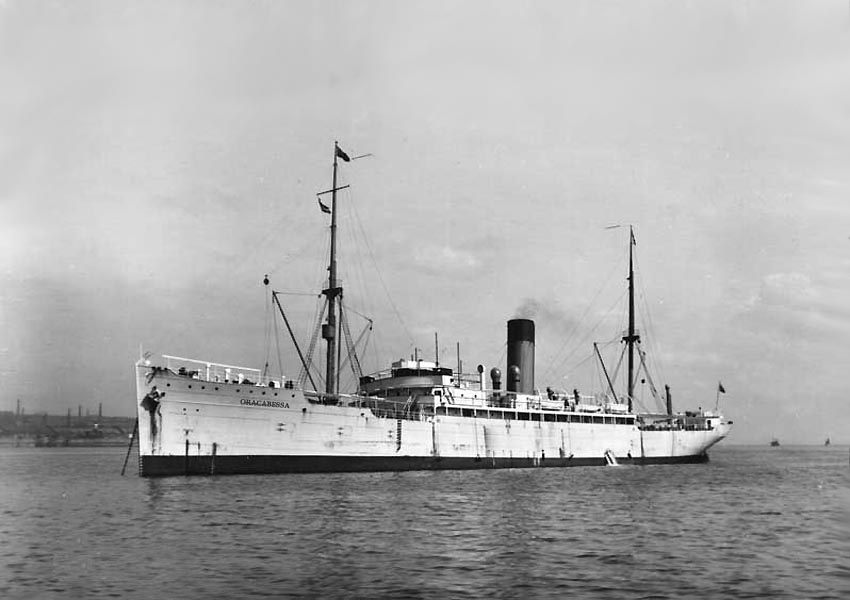
Here we see the SS Oracabessa in 1902
In 1904, three purpose built banana boats were
ordered, each being 3.760 GRT, when completed and placed into service, these
three ships proved a perfect replacement for the original four ships, which
were all sold to the United Fruit Company. The new thing was that these three
new ships did accommodate a small number of passengers and did so in relative
comfort, as it was said; “Especially when compared to the Royal Mail steamers
of that period.” The truth is that these ships were acknowledged as
playing a significant part in bringing the first tourists to
Thus, by the commencement of World War One, the Fyffes fleet had grown to 18 ships, but due to the war most ships had been requisitioned by the Ministry of War to transport troops and other duties. During the war years, ten of the Fyffes ships were sunk by either having been torpedoed or having struck a mine.
Elders & Fyffes Ltd recovered speedily and
in less than five years they had once again become a company with a fine fleet
of ships. But then suddenly a major problem arose, for in 1923 a dock strike
had a huge impact on the company and thus huge losses were incurred, and then
there was the Great Depression throughout the
However in 1928 and 1929 two sisters entered service, the 5.392 GRT SS Tilapa (I), and 5.389 GRT the SS Mopan respectively and both accommodated around 20 passengers. The Mopan was captured and sunk in 1940 by the German battleship Admiral Scheer, and Tilapa (I) came through WW2, and was scrapped in 1959.
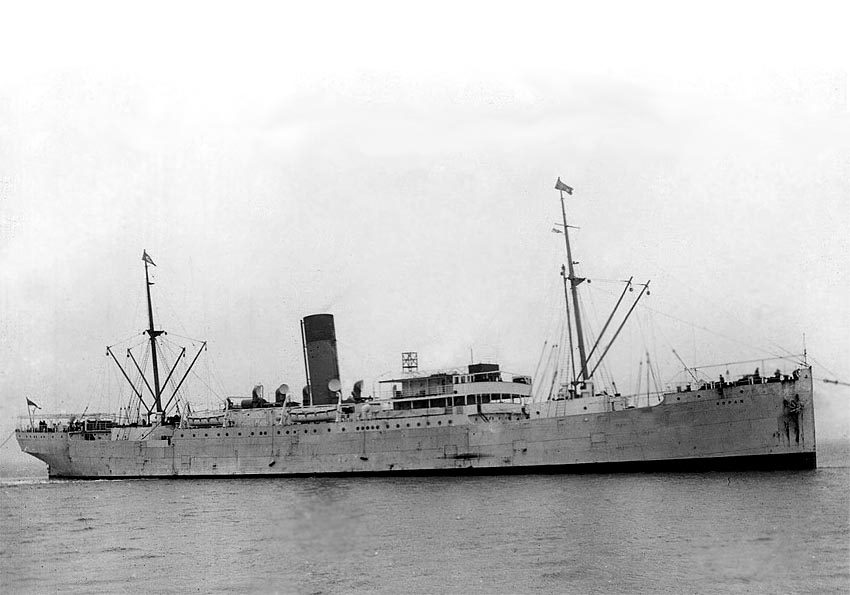
The 1929 built SS Mopan a photo of the Tilapa is just a little further below
As time went by and the year 1938 came around the Fyffes fleet was down to just 21 ships, but back in 1932 they had a fleet of 36 ships, that is a loss of 11 ships due to the hard times they had suffered.
And of course then came World War Two and once again their ships were commissioned into war duties and during the six years of their ships serving in the war, tragically 14 of their ships were lost at sea, thus Fyffes had to rebuild once again.
There were some Fyffe ships that remained in
commercial operation during the war, and continued to sail to Jamaica but
amazingly another problem arose, for in November 1940 the British Government
imposed a complete ban on the importation of bananas, and had been decided that
the only fruit that could be imported into the United Kingdom for the duration
of the war was oranges. This ban continued until December 30, 1945 when the
6.738 GRT SS Tilapa arrived in the
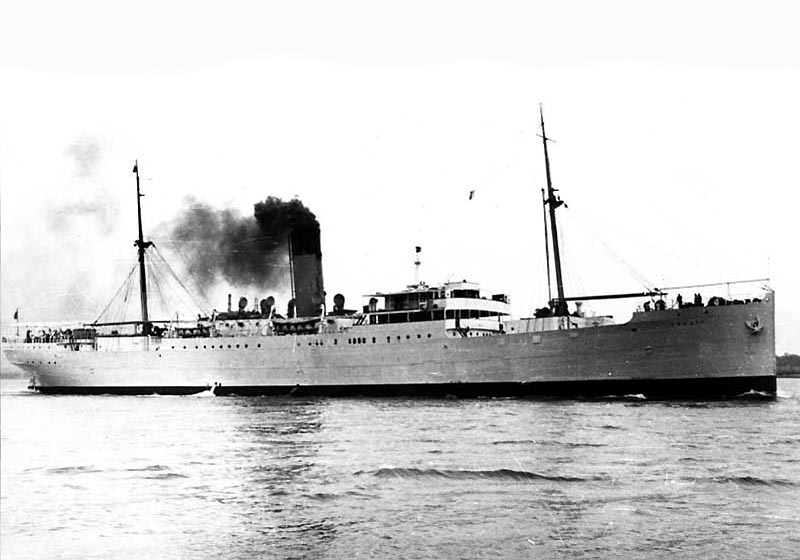
The 1928 built SS Tilapa, which also accommodated some 20 passengers
Fyffes regularly carried distinguished
passengers on its ships including Princess Alice, Countess of Athlete, who, as
Chancellor of the University of the West Indies, made frequent visits to
Jamaica and the West Indies Cricket Team who came to play Test Matches in England
(the team always ended their visit by playing a private game against Elders
& Fyffes own cricket team at the company’s sports ground in New
Malden, Surrey). To this end, it built two final ships the TSS Golfito and TSS
Camito, which provided a fortnightly service between the
Introduction to the TSS
Golfito & Camito:
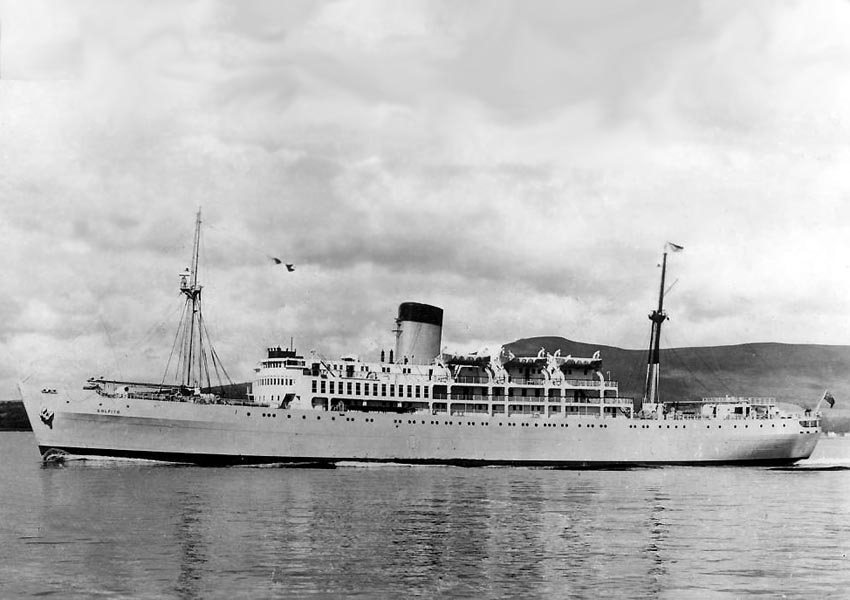
The Elders and Fyffes passenger-banana ship the TSS Golfito
This feature is all about two amazing
passenger-banana liners being part of a fleet of ships owned and operated by
the British banana importer Elders and Fyffes Limited.
There will be many who will recall the days
when a voyage on one of the wonderful Elders & Fyffes banana ships that
invoked so many romantic, seagoing memories, of a long and a memorable
voyage featuring tropical nights and many wonderful ports of call, visiting
some amazing Caribbean destinations. The much-loved TSS Golfito and her
slightly newer sister the TSS Camito were very similar in every respect,
and they operated on what was a popular passenger service from
The Ships:
Both ships were built by Alexander Stephen and
Sons of Glasgow, Scotland, whilst the 8.687 GRT - TSS Golfito was built in
yard 618, and was launched on October 6, 1948 and was completed on December 3,
1949. The Golfito was 448ft - 137m long and a beam of 62ft - 19.20m, and a
draught of 26,1ft - 7.95m, having a top speed of 17.7 knots. The Golfito
as built accommodated 94 First Class passengers.
The 8.502 GRT - TSS Camito was built in
yard 649, and was launched on March 27, 1956, and she was completed in
December 1956. Like her earlier sister she was also 448ft - 137m long and a
beam of 63ft - 19.20m, and a draught of 26,1ft - 7.95m, but she had a top
speed of 18 knots. The Camito as built accommodated 96 First Class passengers.
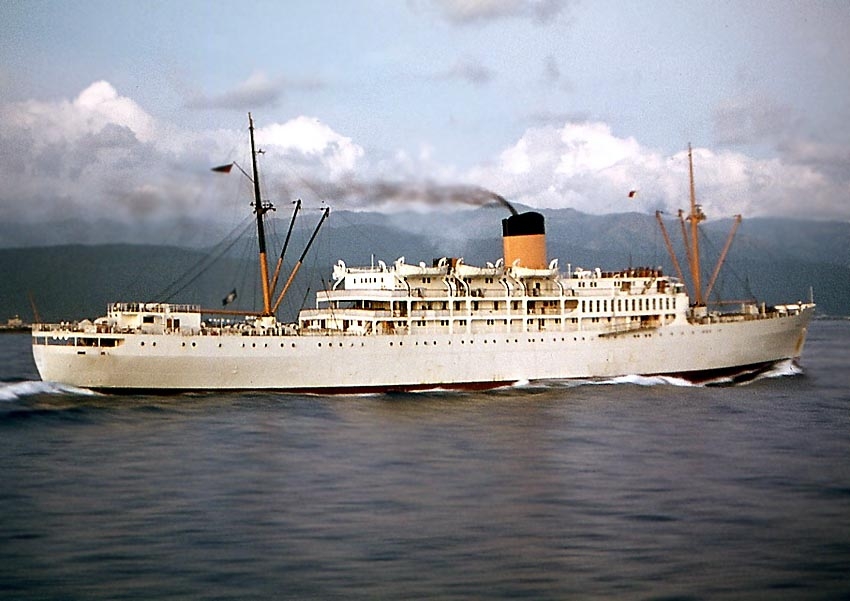
A full
colour stern view of the TSS Camito
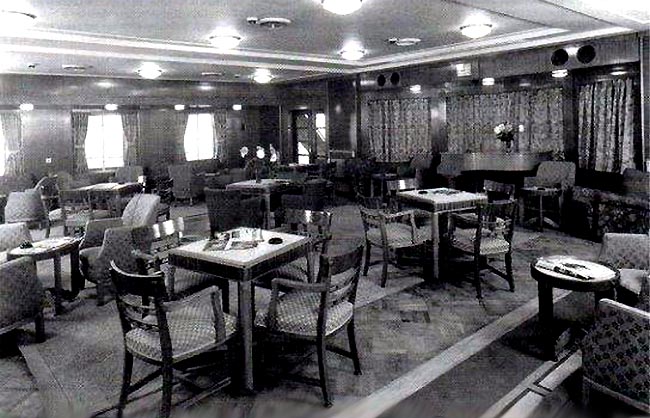
The Lounge, there was a Grand Piano and space for a small band, as there was a dance floor
Provided
by Stan Evans
The Pursers Office
and the shop were based at the main Entrance Hall located on Bridge Deck by the
forward stairwell, whilst the Dining Room was one deck down in front of the same
stairwell on Saloon (Upper) Deck.
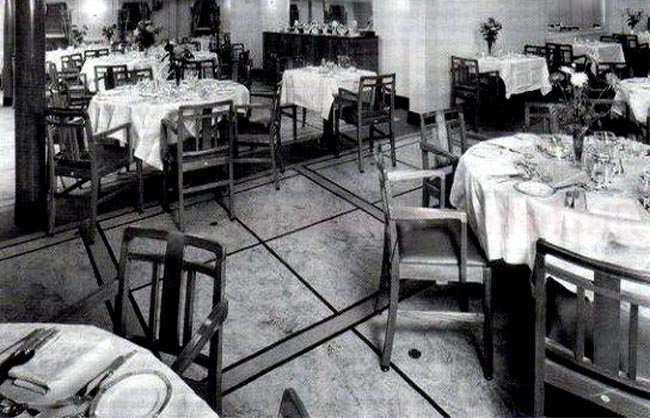
The Dinning Room
Provided
by Stan Evans
TSS Golfito Deck Plan:
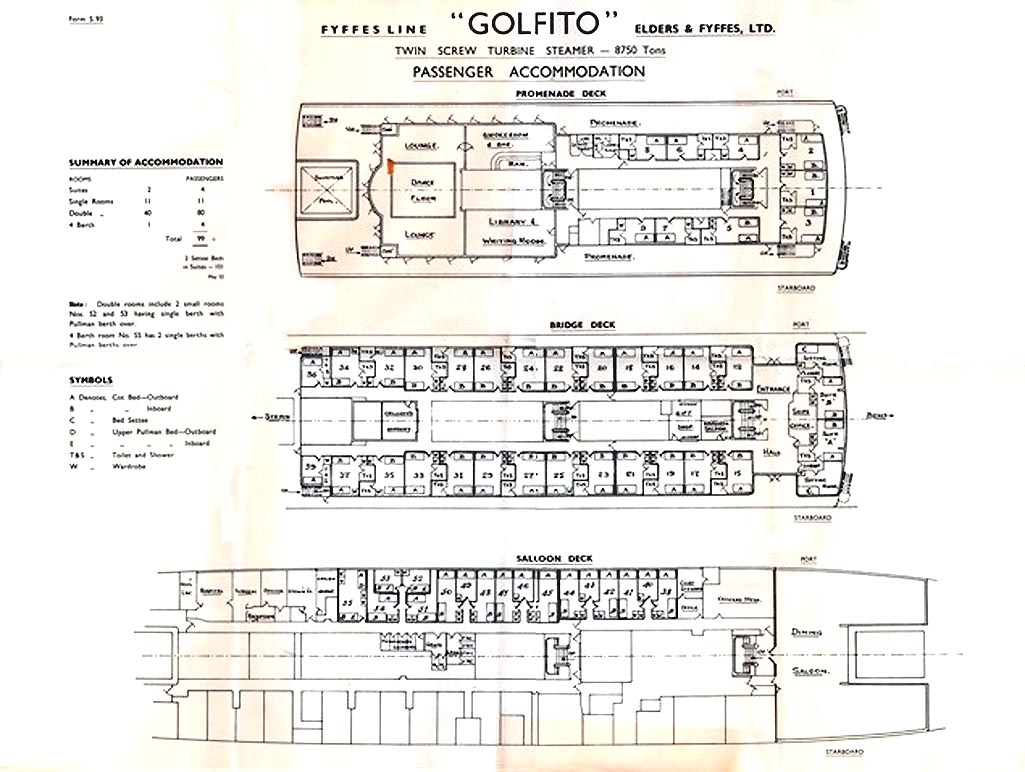
Accommodations:
All cabins and suites were located on the outside having spacious windows or
two portholes on Saloon Deck. Aboard the, at the front of Promenade Deck there
were a total of nine businessman cabins, three of these were more spacious. On
the port side there were three single bedded cabins all with a full bathroom
and on the starboard side there was one twin and two single bed cabins, all
cabins having full bathrooms. On Bridge Deck far forward were two spacious
deluxe Suites that had a separate lounge, bedroom, as well as an upgraded
spacious bathroom. Whilst directly aft on the portside there were twelve twin
bedded cabins all with bath, and one single bed cabin with private facilities
that had a shower. This arrangement was identical on the starboard side twelve
twins and one single, etc. On the portside of Saloon Deck there were ten twin
bedded cabins and four singles as well as one four-berth cabin aft. Some had
private facilities, others were share facilities based. There were some cabins
on Saloon Deck that has a
I regret that to date I have been unavailable
to obtain any photographs of her public venues, cabins or deck spaces. Should
any ever come to hand, I will of course publish these, all being well!
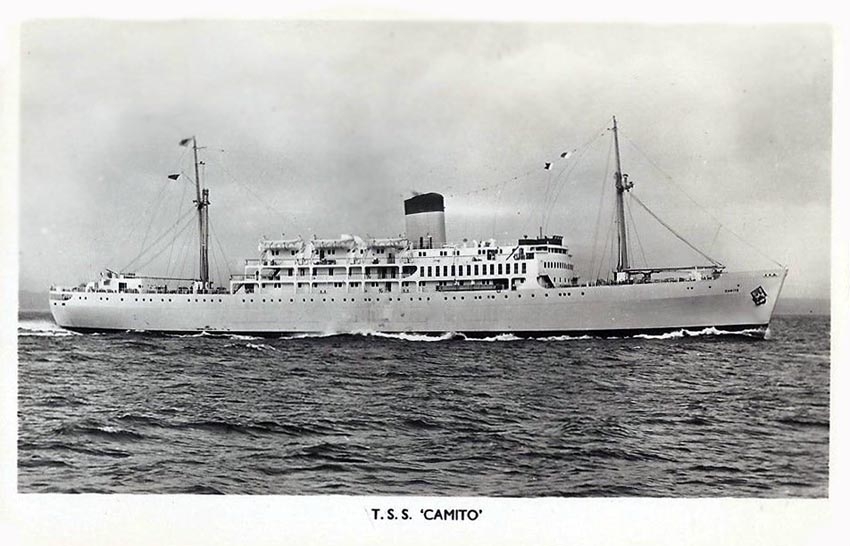
A
postcard of the TSS Camito sold onboard the ship
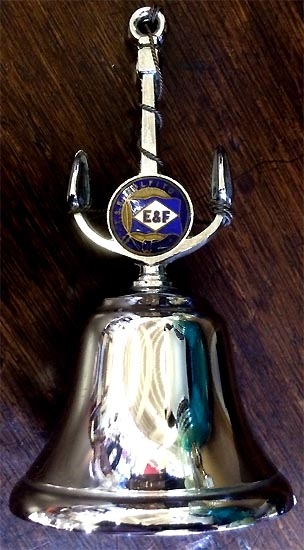
An Elders & Fyffes souvenir Silver Bell as sold in their ship shop
Cargo & Schedules:
Both ships had four large cargo holds, two
being located forward, and two holds aft. They could handle 140,000 stems, or
1,750 tons of bananas. During their voyage to the
The TSS Golfito and Camito provided
a regular fortnightly service sailing from the Southampton ‘Empress
Dock’, which was located directly across from the Ocean Terminal, where
the far superior Cunard Queens berthed, and these passenger banana ships would
sail to and from the
Southampton Empress Dock, or Avonmouth (Bristol) England to Barbados and Trinidad and also the following five ports in Jamaica being; Kingston, Port Antonio, Montego Bay, Oracabessa, and Bowden where bananas would be loaded during in the cool of the night, and then ships returned to the U.K.
Over the years passengers on these two fine ships proved to be very loyal and they would return again and again, for they loved these smaller and intimate ships and tended to take round voyages, thus a month long cruise.
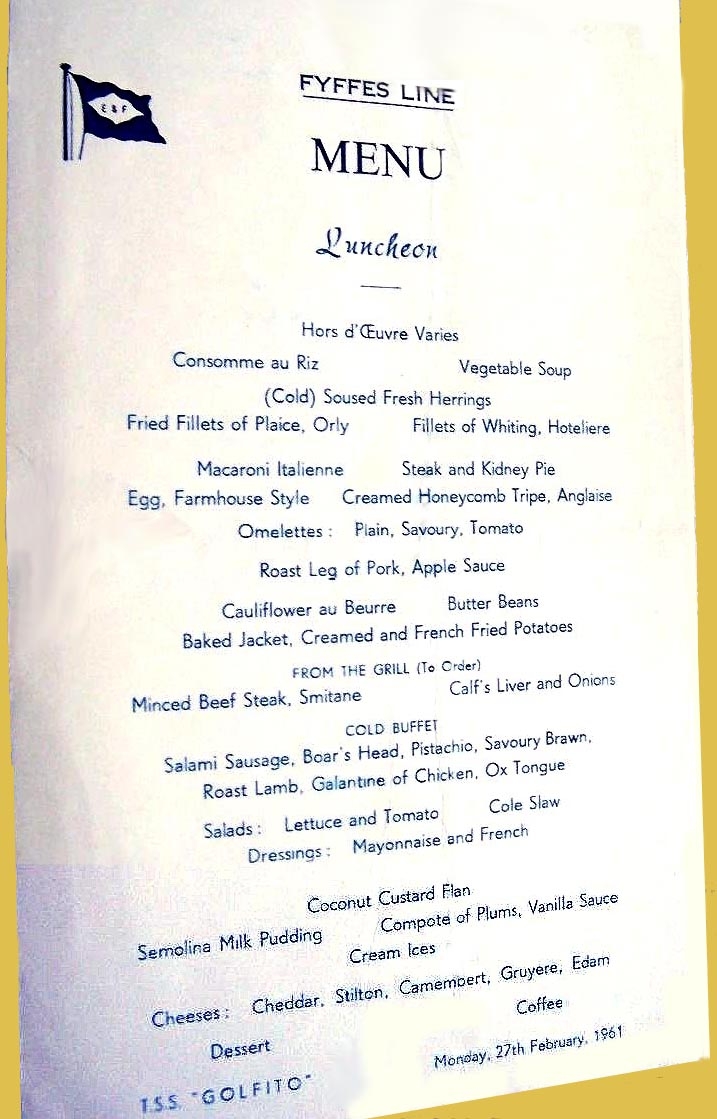
A TSS Golfito Luncheon Menu from February 27, 1961
Sent in
by Hugh Maccallum -
A berth in one of the two luxury two roomed
Owners suites in 1969 would cost 549 English pounds, 19 shillings, and 6 pence,
for those days that was a great deal of money, but then these two suites were
the very best accommodations aboard, amazingly until the late fifties these
suites were not even air-conditioned, that only occurred in 1961. The Golfito
and Camito, as well as other Fyffes’ ships would often carry many
consular staff to and from the West Indies, along with all their belongings, as
they would be living there for extended periods, Besides consular staff, these
two fine ships would also frequently carry businessmen, colonial
administrators, and even royalty to and from the Caribbean. The Camito varied
slightly and she had two four-berth cabins and just two or three less of either
twin or single bed cabins. Sadly the information is just not available for me
to be precise.
Refit:
Both the TSS Golfito and Camito received a refit
in 1960’s, which saw a slightly increased passenger numbers, with the
Golfito increasing to 101 passengers as well as children’s berths, and
the Camito 103 passengers and 10 children’s berths. Both ships also saw
their tonnage increase somewhat. Please see the Ship Specifications section
below for full details.
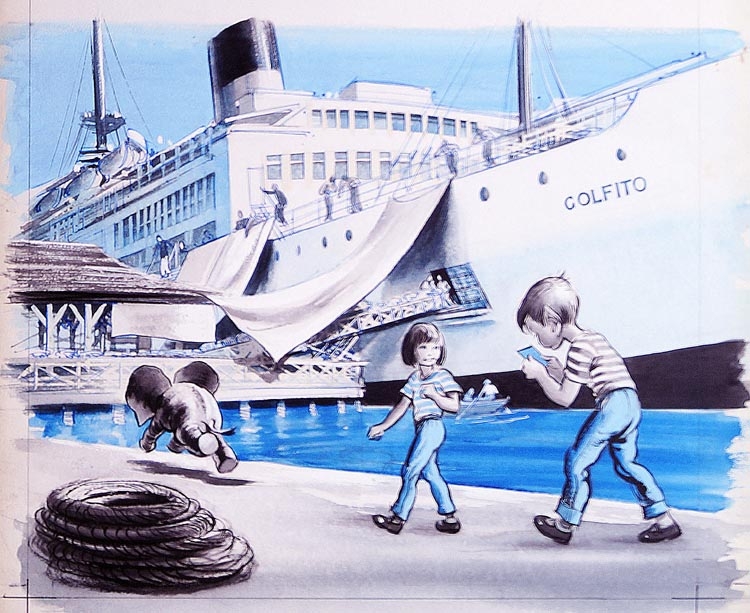
A delightful light-hearted artist’s impression of the TSS Golfito and children at play on the dock
Sent in
by Hugh Maccallum - Edinburgh but artist is unknown
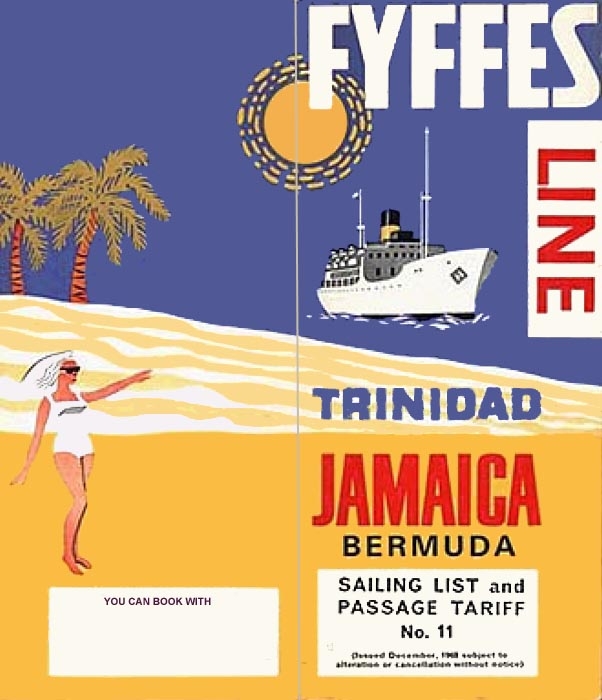
A brochure promoting the TSS Golfito and Camito from the late 1960’s
Sent in
by Hugh Maccallum -
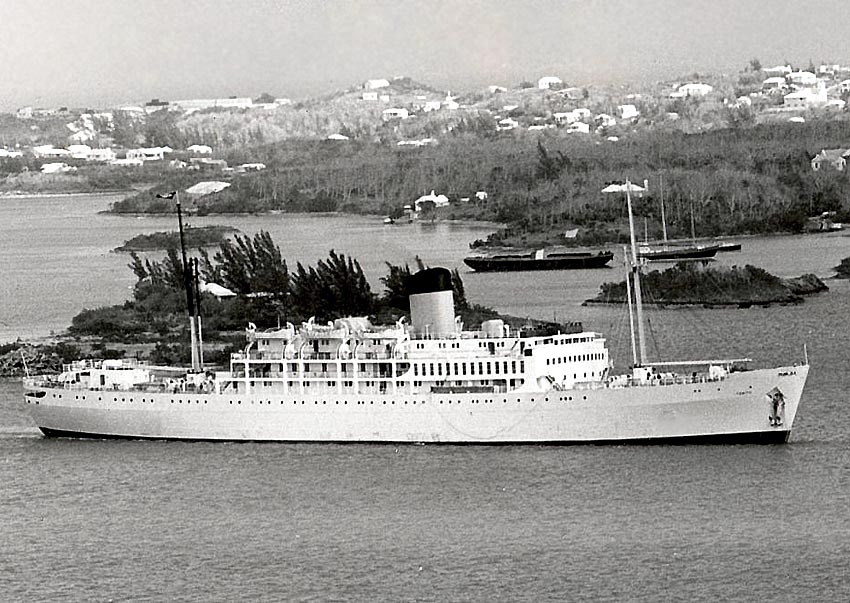
The
delightful Camito is seen arriving in
Photograph by & © Captain Stephen J. Card
In 1962 the very first and much loved James Bond movie DR. No with Sean Connery as 007, and actress Ursula Andress, there is a scene where the Golfito can be seen in the background at the point when James Bond meets ‘Quarrel’ as well as in several other scenes.
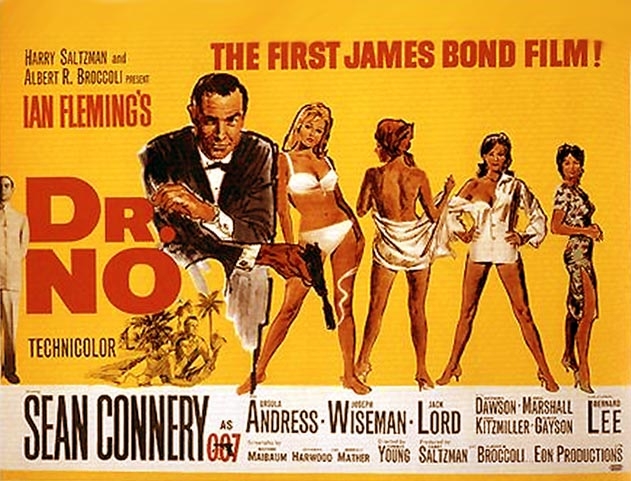
This is the original Dr. No poster
T.S.S. Golfito & Camito Final
Days:
However, as the 1960.s went on, it became very obvious that these fine and once exceedingly popular Passenger-Banana Ships were losing much of their earlier clientele, and it is sad to say, they were now utilising those new fast jet planes, which saw them at their destination fast and they could have a holiday on a tropical Island instead of an long ocean voyage.
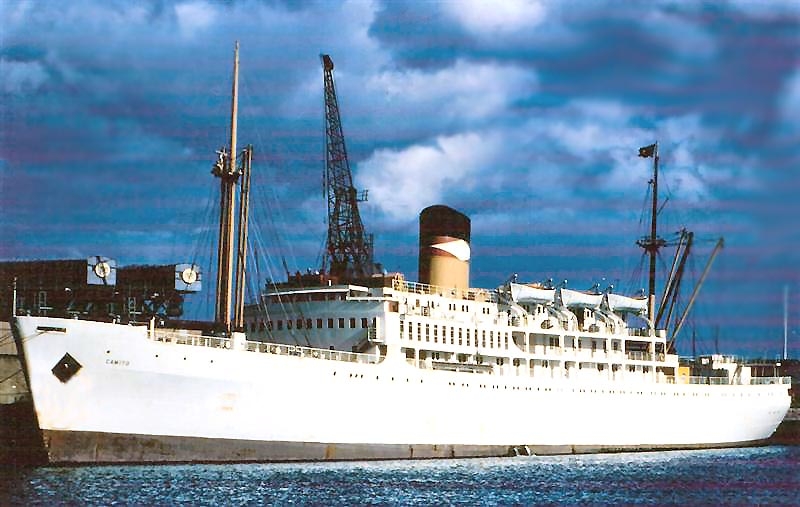
The TSS Camito is seen in her final days with her new Fyffes Group Ltd funnel livery
Photographer is unknown, please read the Photo Notes at the bottom of the page.
In addition both ships were slowly growing older and due to reduced passenger loadings they had become less and less profitable. It is for this reason that the “Fyffes Group Ltd to completely end the days of their big “Passenger-Banana ships,” and conclude all passenger operations. For this reason, Fyffes decided to sell both their ships, with the Golfito being the first to go, later followed by the Camito as shown below.
TSS Golfito was obtained by ‘Shipbreaking Industries Ltd’ in December 1971,
and she arrived at
For Interest Ship Prefix
Ships with a prefix such as … T.S.S. is an abbreviation for these ships being “Twin Screw Ships,” however, it can also mean “Turbine Steam Ship” as with some other ships. But T.S.S. - “Twin Screw Ships,” was the Golfito and Camito’s “official’ designation by her owners, Elders and Fyffes, which later became the “Fyffes Group Ltd.”
Then there is also the prefix S.S. which stands for “Steam Ship,” and there were a good number of ships prefixed M.S. meaning “Motor Ship.” These days with a world filled by cruise ships, these ships of all sizes are mostly prefixed with M.V. standing for “Motor Vessel.”
Specifications (1)
Built by:………………………………………………..
Yard:………………………………………………………(1) 618.
Yard:……………………………………….……….……(2) 649.
Owner:……………………………………….…………..Elders
& Fyffes Ltd,.
Operator:…………………….…………………………Elders
& Fyffes Ltd,.
Official Nr:…………..….………
…………….….…(1) 182119.
Official Nr:……………...………
…………….….…(2) 185049.
Launched:……………………………………………..(1) October 6, 1948.
Launched:……………………………………………..(2) March 27, 1956.
Completed:………………….……….… . ………(1) December 3, 1949.
Tonnage:……………………………….…….……….(1) 8.687 GRT, 4.474 NET / 5.800 DWT - in 1961, 8.740 GRT.
Tonnage:……………………………….…….……….(2)
8.502 GRT, 4.131 NET / 5.995 DWT - in 1961 8.736 GRT.
Length:………………………………….………………448ft - 137m.
Width:……………………………………….……,,……63ft - 19.20m.
Draught:…………………………………….………… 26,1ft 7.9.m.
Engines:…………………………………….….……….Steam D.R. Geared Turbines.
Propellers:……………………………………….……Twin screw.
Speed:…………………………………………………..17.7 knots, 18.5 knots maximum.
Passengers:…………………………………………..(1) 94 as built & 111 First Class in 1960s.
Passengers:…………………………………………..(2) 96 as built & 113 First Class in 1960s.
Remembering Two Fine Elders & Fyffes Banana Ships
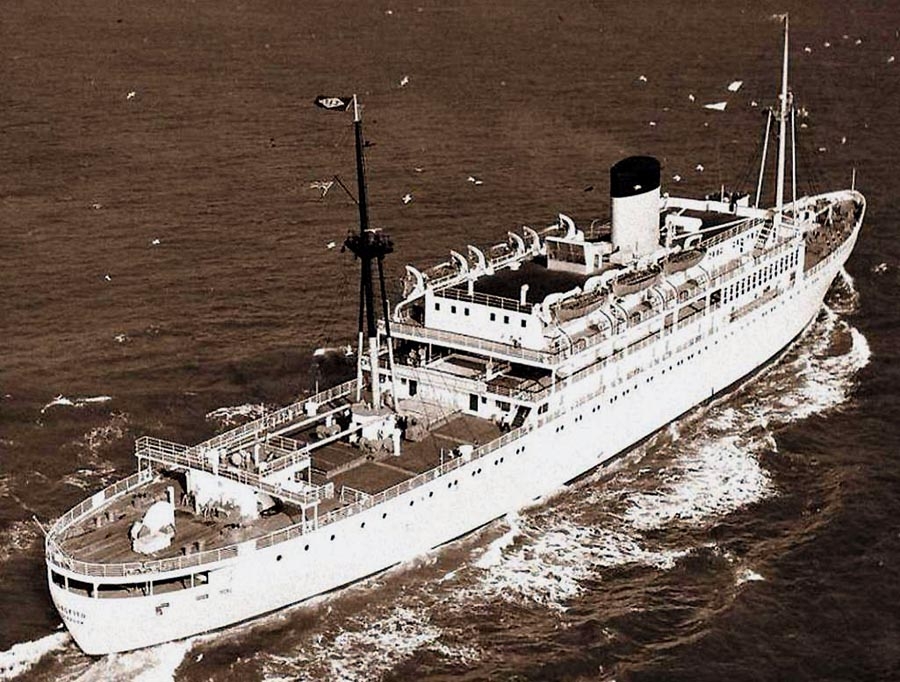
A
Postcard with an excellent aerial view of the TSS Golfito
I hereby wish to thank:
Mr. Hugh Maccallum
from
************************
I watched them come, I watched them go, and I watched them die.”
************************
ENTER OUR ssMaritime MAIN INDEX
This notice covers all pages, although, and I have done my best to
ensure that all photographs are duly credited and that this notice is displaced
on each page, that is, when a page is updated!
